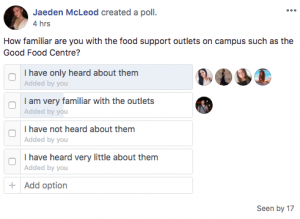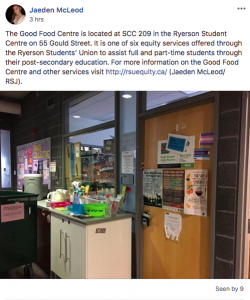Student Food-Insecurity Today …
The Fourth Annual Hunger Report from Ryerson’s Good Food Centre (GFC) highlights the seldom mentioned issue of food insecurity facing two in five Canadian post-secondary students.
“The issue is very normalized,” said Jaimie White, one of the authors of the Hunger Report. “As students, we need to understand the stress that worrying about food can have on ourselves and our fellow students.”
The report found that post-secondary seconds are three times more likely to be at risk of food insecurity compared to the rest of Canada. At Ryerson University, over a quarter of students face food insecurity.
Food security is “when all people, at all times, have access to sufficient, safe and nutritious food to meet their dietary patterns and food preferences for an active and healthy life,” said the report.
Of Ryerson’s food-insecure students, 73 per cent are people of color, 34 per cent are students in the Faculty of Engineering and Architecture, and 33 per cent are mature students. 52 per cent of those who accessed Ryerson’s GFC were female.
People of colour are drastically overrepresented because of “socioeconomic disadvantages and discrimination” which contribute directly to food insecurity. Students in the Faculty of Engineering and Architecture also pay $1,000 to $2,000 more in tuition and typically take on more courses then the average Ryerson student said the report, which leads to their overrepresentation as food-insecure as well.
Speak Visually. Create an infographic with Visme
Other reasons for food insecurity recognized by the report include rising tuition rates, the additional costs such as laptop and books prices, and the skyrocketing prices of Toronto rent.
“There is a ‘starving student’ stereotype that pervades conversations about the issue. A common understanding of student food insecurity is that it is a normal feature of student life and a necessary ‘rite of passage’” said the report, adding that food insecurity ought to never be considered “normal.”
The Recommended Response …
The most notable suggestion to improve the state of Ryerson’s food security was the recommendation to remove the GFC from the RSU.
Speak Visually. Create an infographic with Visme
“The high turnover rate [of the RSU executive] each year has negatively impacted the consistency of services offered by the Good Food Centre,” said the report.
The RSU said they do not agree with the reports suggestion to cut ties.
“RSU employees and volunteers work closely with the Good Food Centre to provide more access for students, not only by supplying food but by providing meals and free breakfast on campus to students on designated dates throughout the semester,” said RSU Lead of Communications Serena Dhillon.

“Maintaining [the GFC] connection with the RSU will allow for more funding, budget review, and more publication and support by fellow students and employees. If ties were cut, then the GFC would have no funding.”
The report also suggested that Ryerson do more to advocate food-security, rather than leaving the work to student groups.

Fiona Yeudall, director of Ryerson’s Centre for Studies in Food Security (CSFS), said that Ryerson University continually gives large investments to programs such as Ryerson’s Urban Garden and the CSFS itself.
The CSFS is a Ryerson institution which “supports education, research, and community service and conferences” for food security, said Yeudall.
Yeudall added that the RSU levy which students passed last year, granting the Good Food Centre $186,265 annually from student tuition, is another example of Ryerson’s support for food security.
Jaimie White, one author of the Hunger Report, suggested that students involve themselves in the effort, as well.
“If students have the capacity, they can get involved as a volunteer or join other students in advocating for food security on campus,” she said. “We need to support each other, help students access the services that exist and advocate for more collaborative action to address student food-insecurity on campus.”

Leave a Reply